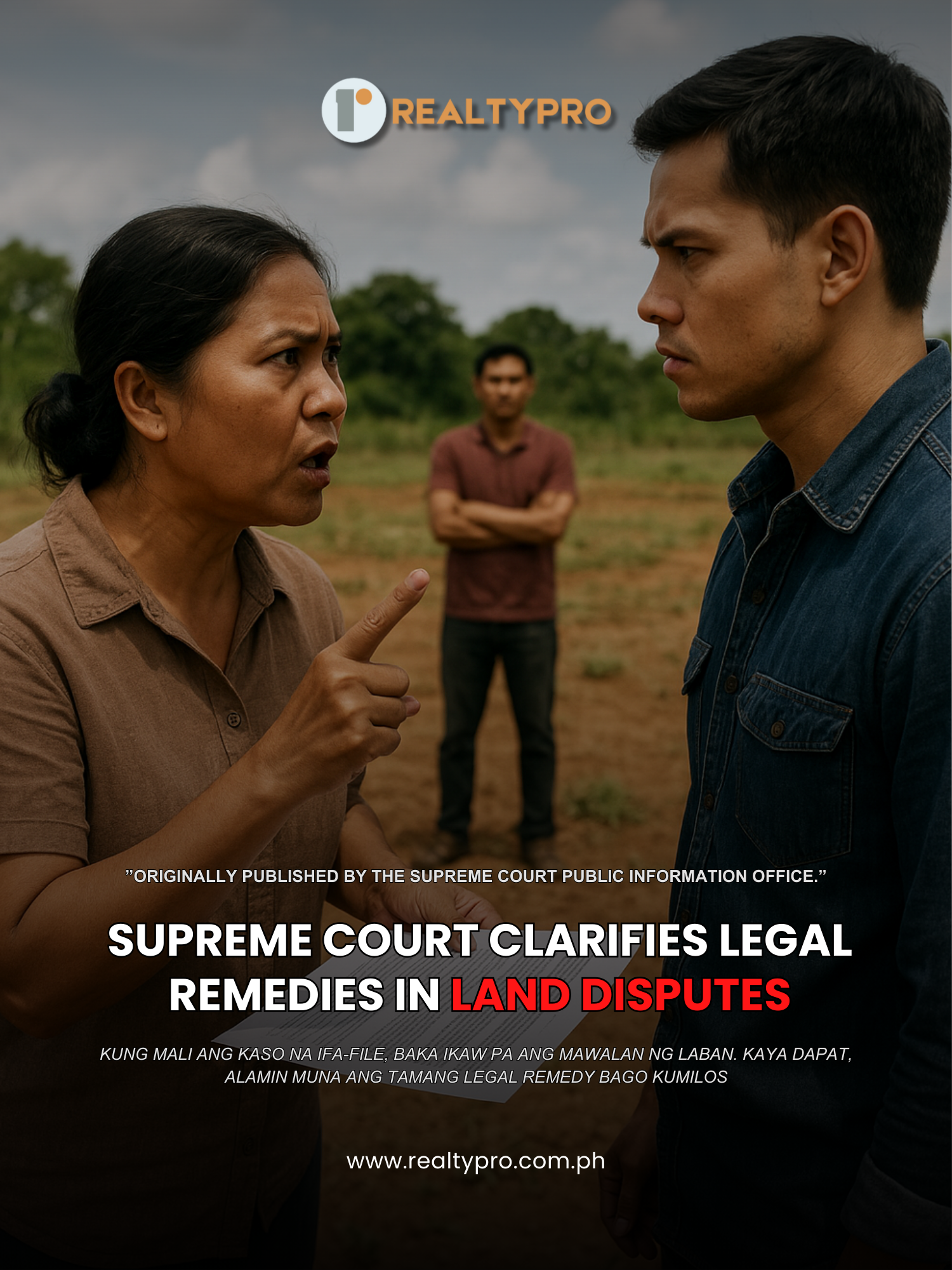Supreme Court Clarifies Legal Remedies in Land Disputes
Introduction
Land ownership and possession disputes are not new in the Philippines. Whether it’s a matter of ejecting a stubborn occupant or reclaiming what is legally yours, the choice of legal remedy can spell the difference between winning or losing your case. Recently, the Supreme Court (SC), through an En Banc decision penned by Associate Justice Ricardo R. Rosario, clarified the proper legal actions that landowners should take depending on the circumstances of dispossession.
This ruling serves as an important guide not only for lawyers but also for property owners, real estate professionals, and the general public who may one day find themselves in a similar situation.
Three Legal Remedies for Land Disputes
The SC explained that there are three main legal remedies when it comes to recovering land:
- Ejectment – This covers forcible entry or unlawful detainer. It applies when a person is deprived of possession through force, intimidation, threat, strategy, or stealth. An ejectment case must be filed within one year from the time of dispossession.
- Accion Publiciana – This action is filed to recover possession after one year has passed since dispossession. However, the SC clarified that it may also be filed even within one year, provided that the dispossession did not involve force or similar unlawful means. The focus here is who has the better right to possess the property.
- Accion Reivindicatoria – This is an action to recover both ownership and possession of land. The case involves proving ownership itself, and once ownership is established, possession is naturally awarded to the rightful owner.
The Case That Sparked Clarification
In the case that reached the SC, the property owner purchased a piece of land only to find that it was partly occupied by another party who refused to vacate despite demand. The landowner filed a case before the Regional Trial Court (RTC), invoking her right to possession.
The RTC dismissed the case outright, reasoning that it was filed too early, since she still had the option to file an ejectment case within one year of discovering the occupation. According to the trial court, an accion publiciana can only be filed after one year from dispossession.
The Court of Appeals (CA), however, disagreed. It ruled that the case was actually an accion reivindicatoria since the owner’s claim was anchored on her title to the property.
This conflicting interpretation led to an appeal before the Supreme Court.
The Supreme Court’s Clarification
The SC ultimately ruled that the case filed was indeed an accion publiciana, not an accion reivindicatoria. The landowner was not disputing ownership; instead, she was asserting her right to possession. Importantly, the Court clarified that:
- An accion publiciana need not always wait for the one-year period to lapse.
- If the occupation of land was not through force, intimidation, threat, strategy, or stealth, then even if less than a year has passed, an accion publiciana is still a proper remedy.
The SC emphasized that the RTC erred in prematurely dismissing the case. It ordered the trial court to proceed with the hearing and resolve the dispute on its merits.
Why This Matters
This ruling is crucial because it removes uncertainty for landowners. Many are caught in a dilemma of whether to file ejectment or accion publiciana, and timing is often the key factor. The SC’s decision provides clarity: what matters more is the manner of dispossession, not strictly the one-year rule.
For real estate professionals, this decision reinforces the importance of guiding clients on the right legal strategy when it comes to land possession disputes. Filing the wrong case can mean wasted time, effort, and money.
Conclusion
Land ownership and possession cases can be tricky, but this Supreme Court ruling offers much-needed guidance. By clearly distinguishing the remedies and relaxing the rigid interpretation of the one-year rule in accion publiciana, the Court has made it easier for rightful owners to assert their rights without fear of technical dismissal.
In short, kung may lupa ka at biglang may nakikitira o umaangkin, importante na alam mo kung anong kaso ang dapat isampa. Hindi lang ito para sa mga abogado o real estate practitioners—pati ordinaryong tao dapat informed. Tandaan: kung mali ang kaso na ifa-file, baka ikaw pa ang mawalan ng laban. Kaya dapat, alamin muna ang tamang legal remedy bago kumilos.
References
For the case full text read here
For Legal and Real Estate Assistance, Click Here
Originally published by the Supreme Court Public Information Office.
#rltypro #SupremeCourtPH


